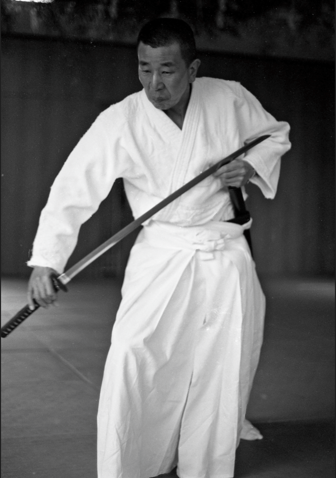Michio Hikitsuchi
This page is informative only. Hikitsuchi Sensei has passed and what follows is a mere reflection of his legacy left behind.
Michio Hikitsuchi (引土道雄Hikitsuchi Michio, July 14, 1923 – February 2, 2004) was an aikido instructor and the Dojo Cho (Chief Instructor) of the Kumano Juku Dojo, in Shingu, Wakayama Prefecture, Japan, for fifty years.
At nine years old he began kendo and later kenjutsu, jujutsu, bojutsu and karate. Hikitsuchi trained extensively in Jūkendō (bayonet) as a young man, and was very skilled in both iaido and kendo.
When he was fourteen years old, he met Morihei Ueshiba for the first time. At that time there was an age requirement for studying budo with Uesiba, but they made an exception for Hikitsuchi.
Hikitsuchi recounts a midnight, lights-out training with Ueshiba, in which he cut off the tip of Ueshiba’s bokken. The piece flew off, and he searched throughout the dojo for it. Eventually, Ueshiba pulled it out of the folds of his kimono, praising him highly for his skill. Months later, Ueshiba gave Hikitsuchi a scroll entitled “Bojutsu Masakatsu Agatsu” - True Victory is Self-Victory. The scroll was extensively illustrated by a famous artist, and contained Ueshiba's written explanations of techniques. Meik Skoss, who has viewed the scroll, wrote, “One of the phrases on the scroll is very interesting, ‘each of these pictures is the seed for a hundred techniques; study them well.’”
Michio Hikitsuchi received his 10th dan in 1969, three months before Ueshiba's death.
Hikitsuchi taught as chief instructor of Kumano Juku Dojo in Shingu, Japan until his death in 2004. The dojo was founded by Ueshiba in 1953. Hikitsuchi traveled twice to the United States, and regularly to European countries, teaching at dojos that had been started by his students.
Hikitsuchi was described by other teachers in Shingu as 'an Aiki computer' because of his ability to recite virtually verbatim the speeches Ueshiba had given. He also had extensive knowledge of Shinto Norito (chanting) and the spiritual teachings of the Kojiki—areas of personal emphasis by his teacher, the founder of aikido. Hikitsuchi's reverence for Ueshiba and his message was total.
The Founder of Aikido | Morihei Ueshiba
Morihei Ueshiba, better know as OSensei is no longer with us. This page is a subtle attempt at educating the public about the man he once was.
Morihei Ueshiba (植芝盛平Ueshiba Morihei, December 14, 1883 – April 26, 1969) was a martial artist and founder of the Japanese martial art of aikido. He is often referred to as "the founder" Kaiso (開祖?) or Ōsensei (大先生/翁先生), "Great Teacher".
The son of a landowner from Tanabe, Ueshiba studied a number of martial arts in his youth, and served in the Japanese Army during the Russo-Japanese War. After being discharged in 1907, he moved to Hokkaidō as the head of a pioneer settlement; here he met and studied with Takeda Sokaku, the founder of Daitō-ryū aiki-jūjutsu. On leaving Hokkaido in 1919, Ueshiba joined the Ōmoto-kyō movement, a Shinto sect, in Ayabe, where he served as a martial arts instructor and opened his first dojo. He accompanied the head of the Ōmoto-kyō group, Onisaburo Deguchi, on an expedition to Mongolia in 1924, where they were captured by Chinese troops and returned to Japan. The following year, he experienced a great spiritual enlightenment, stating that, "a golden spirit sprang up from the ground, veiled my body, and changed my body into a golden one." After this experience, his martial arts skill appeared greatly increased.
Ueshiba moved to Tokyo in 1926, where he set up the Aikikai Hombu Dojo | Aikido Headquarters. In the aftermath of World War II the dojo was closed, but Ueshiba continued training at another dojo he had set up in Iwama. From the end of the war until the 1960s, he worked to promote aikido throughout Japan and abroad. He died from liver cancer in 1969.
In 1969, Ueshiba became ill. He led his last training session on March 10, and was subsequently taken to hospital where he was diagnosed with cancer of the liver. He died suddenly on April 26, 1969. Two months later, his wife Hatsu also died.(植芝はつ; Ueshiba Hatsu, née Itokawa Hatsu; 1881–1969)


